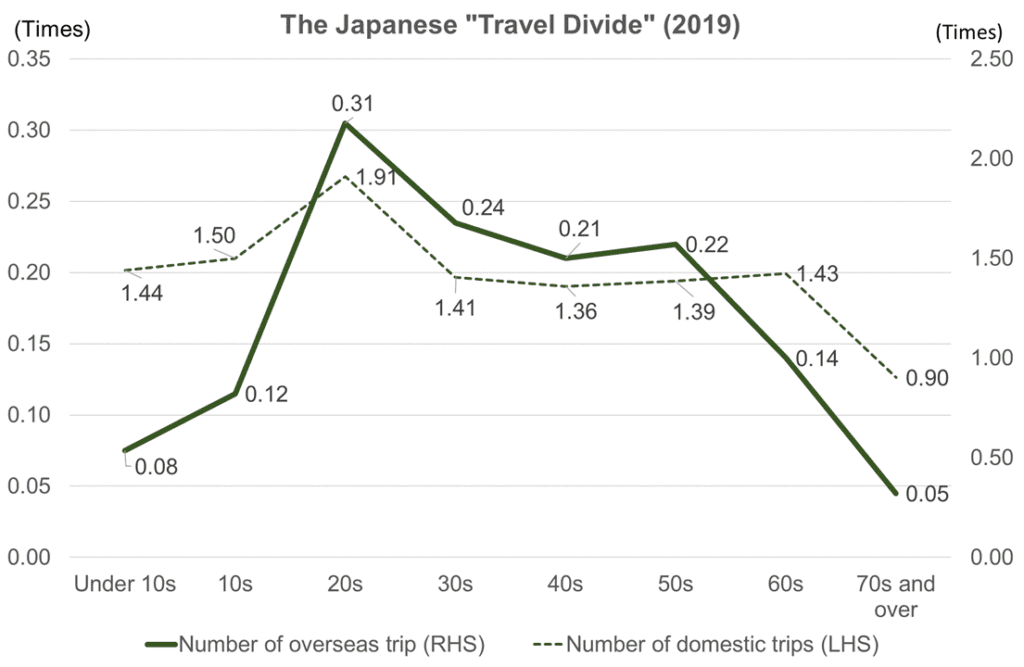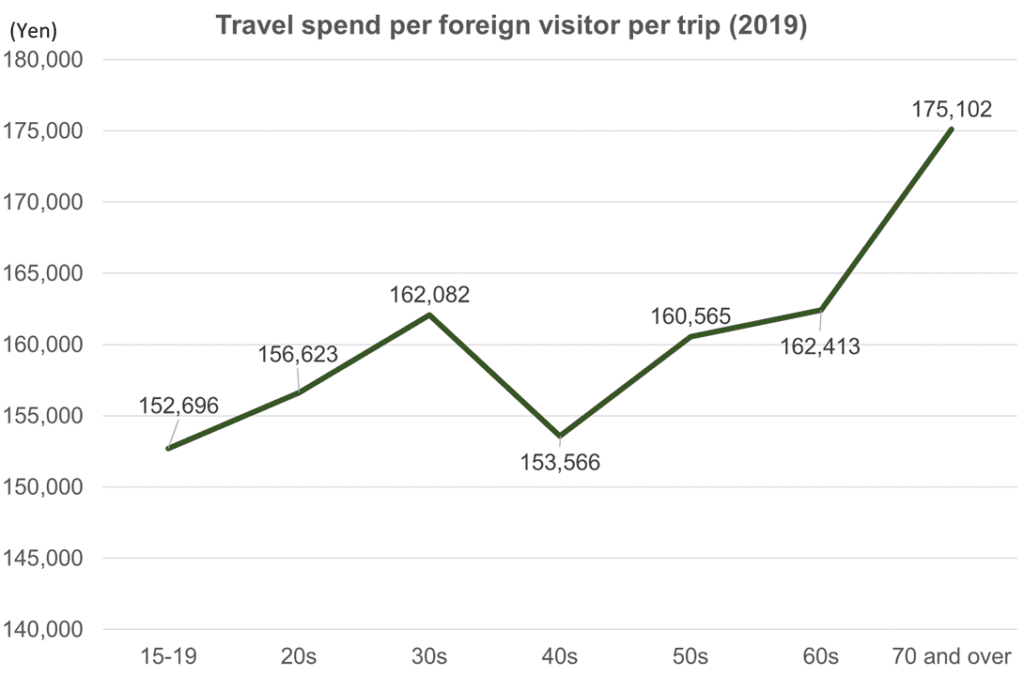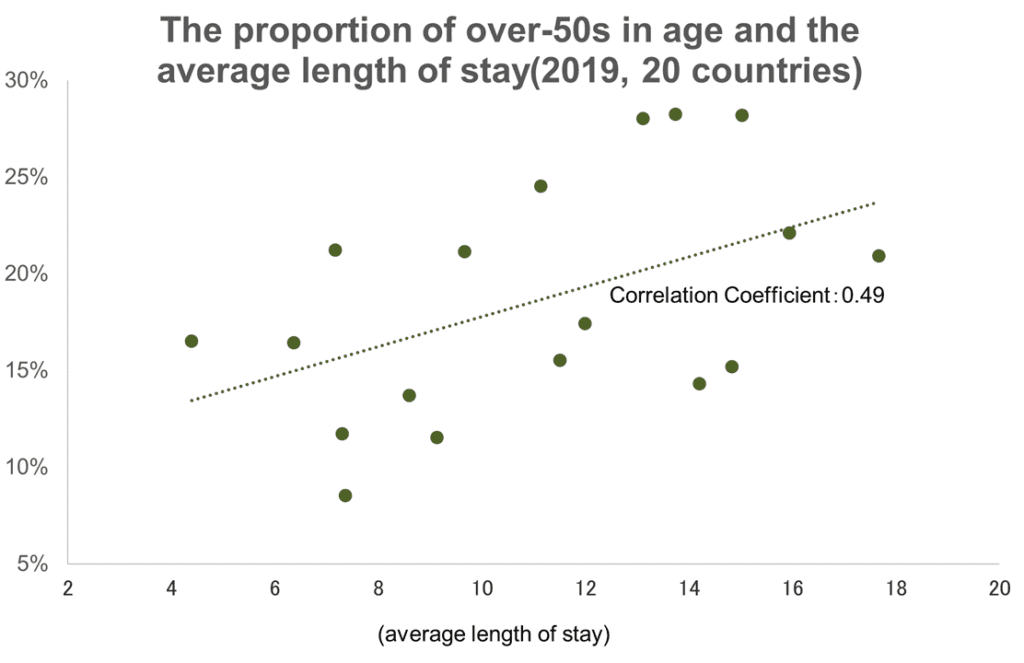The economic impact of the increased number of senior inbound visitors: An Analysis of the “Travel Divide” (7)
This post is the final installment of our “Travel Divide” discussion. We will analyze the economic impact if the senior (elderly) segment of inbound visitors increases the number of trips they make.
The proportion of inbound travelers by age group is 10% for those in their 50s and 5% for those in their 60s or older (according to the Japan Tourism Agency’s “2019 Annual Report on Spending Trends of Foreign Visitors to Japan“), a figure that may surprise many in the travel industry. The 85% of inbound travelers under the age of 40 indicate that a serious “travel divide” is occurring among inbound travelers.

Sources: JTB Travel Annual Report 2020; Japan Tourism Agency, “2019 Annual Report on Consumption Trends of Foreign Visitors to Japan.
According to the United Nations State of World Population 2023, the percentage of the population aged 65 and over is 10% for the world and 20% for the more developed regions. The rate of inbound visitors in their 60s and over is 5%, which is still relatively small.
On the other hand, Japanese domestic travelers in their 50s or older, as pointed out in the previous report, comprise a significant 41% of the total. This number is much better than the serious “travel divide” of inbound visitors. This difference is the one in travel days between domestic and international travel. The average number of nights of domestic travel by Japanese is 1.70 nights. In comparison, the average number of nights of international travel is 7.79 nights (average number of nights by sightseeing and recreational travel, Japan Tourism Agency, “2019 Travel and Tourism Consumption Trends Survey Annual Report“).

As travel itineraries become longer, the amount of luggage carried becomes larger and heavier, and the number of trips taken by seniors (the elderly) declines. This factor is as we analyzed in “The Surprising Reason for Decreasing Travel Frequency?: Consideration of the “Travel Divide” (3)“. Compared to domestic travel, the Japanese “travel divide” is even more severe for overseas travel: the average number of domestic trips for those aged 70 and over is 1.36, compared to 0.90 (a 34% decrease), while the average number of overseas trips is 0.16, compared to 0.05 (a 72% decrease).

Source: JTB Travel Annual Report 2020 (2019 travel data)
Thus, we found that the senior (elderly) group significantly reduced the number of trips for both inbound visitors and Japanese traveling abroad. However, inbound visitors in the senior (elderly) age group spend more money. According to the Japan Tourism Agency’s “Survey on Trends in Foreign Visitor Spending in Japan (2019),” the average per trip spending per inbound visitor is 158,560 yen, with 1.3% more spent by visitors in their 50s, 2.4% by visitors in their 60s, and 10.4% by visitors in their 70s. Therefore, an increase in the number of trips by seniors is likely to affect boosting consumption directly.

Source: Japan Tourism Agency, “Survey of Foreign Visitor Consumption Trends in Japan (2019)”

We analyzed a scenario in which the number of trips made by inbound visitors in their 50s and older seniors (senior citizens) increases: the average spend per trip by those in their 50s is 160,565 yen, and the average spend per trip by those in their 60s and 70s is 168,757 yen. Based on this standard, a 10% increase in the number of travelers is expected to have an economic impact of 80.7 billion yen, a 20% increase of 161.5 billion yen, and a 30% increase of 242.2 billion yen. 2019 inbound foreign travel spending totaled 4,813.5 billion yen. Therefore, we can analyze the economic effect of the rise in the number of trips by seniors, who spend a large amount of money, which will be huge. In particular, it would be easy to increase the number of trips by those in their 50s, who are still active and energetic, and those in their 60s, who are still energetic even after retiring from work.

Source: Japan Tourism Agency, “Survey of Foreign Visitor Spending Trends in Japan (2019),” our calculations
In addition, inbound visitors from countries with a high percentage of visitors in their 50s or older tend to stay longer in Japan. Longer stays also increase the likelihood of consecutive nights. Their longer stays may contribute to alleviating the labor shortage that has been a problem in Japan’s travel industry (especially in the lodging industry) in recent years. Of course, this is because consecutive nights are less labor-intensive.
 Source: Japan Tourism Agency, “Survey of Foreign Visitor Spending Trends in Japan (2019),” our calculations
Source: Japan Tourism Agency, “Survey of Foreign Visitor Spending Trends in Japan (2019),” our calculations
The above is a seven-part discussion of the “travel divide. We can increase the number of trips by creating an environment where seniors who want to travel can do so with less luggage. This increased number of trips will improve their well-being, reduce the risk of dementia, and bring economic benefits. In addition, the increase in the number of consecutive nights may reduce labor shortages in the travel industry. Furthermore, this initiative will promote universal tourism, benefiting families with disabled persons and infants.
In conclusion, bridging the “travel divide” is socially and economically significant. Of course, making it easier to travel will not only help bridge the “travel divide,” it will also make travel more accessible for all, and the travel industry will prosper. It will also help realize the SDG philosophy of “leaving no one behind.

Our clothing rentals allow luggage to be lightened, making travel more accessible for all, not just seniors (elderly), people with disabilities, and families with infants and toddlers. Furthermore, although clothing rental is a fee borne by the traveler, travelers can also offset a significant portion of the clothing rental fee by reducing checked baggage fees, cab fares, locker fees, etc., due to the presence of luggage. In addition, there is no investment burden on the travel industry or local government. Together, we can promote the spread of clothing rentals for travelers to eliminate the “travel divide” at little or no cost to the many parties involved.

We are currently looking for sales partners for lodging agencies and travel agencies. We invite you to join us in contributing to universal and sustainable tourism by increasing the number of travelers with “zero investment.” We also pay a 10% commission to our partner hotels and travel agencies when sales are recorded (commission rates are subject to change). Please click the button below to learn more about the “benefits for lodging companies and travel agencies” and “benefits for travelers.”
If you are interested, don’t hesitate to contact us. We look forward to working with you.


